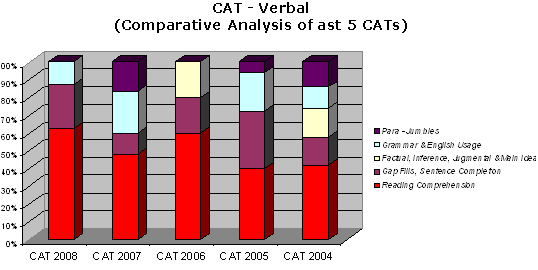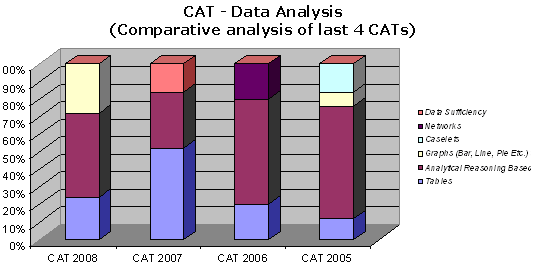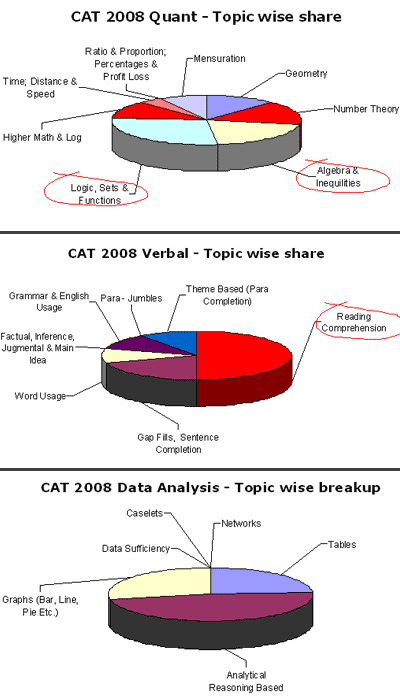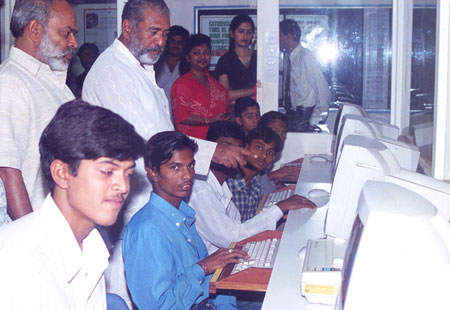cat preparation
Image: With CAT 2009 going online, it is imperative that B-school hopefuls practice taking online tests.
Photographs: Rediff Archives
The CAT has been designed as a test of elimination NOT selection, and this is one of the reasons why aspirants are confused and nervous at this moment. Moreover, most have completed 60-70 per cent of the topics in classroom preparation and it is just a month or two before the national Online Mocks begin.
So what should one do at this crucial juncture?
Experts from www.TCYonline.com suggest that it is the time to plan, strategise and get ready for the perfect execution of that plan. A General's strategic approach is what the need of the hour is rather than a soldier's aggressive approach. Here are the few important areas that you will need to work on in order to stay focused for the new tech-CAT avatar:
Know the challenges and myths surrounding Online CAT '09
The first step in any winning strategy is to know your enemy. You must visualise the challenges that CAT '09 is expected to offer. Moreover, you will see that many previously accepted facts regarding the CAT have now become myths because of it going online this year. (Read: https://getahead.rediff.com/report/2009/apr/29/cat-online-challenges-myths.htm)

Image: Test-takers can improve their performance by reading online editions of newspapers.
Photographs: Savita Kirloskar/REUTERS
A factual, exhaustive and balanced study plan must have both 'macro' and 'micro' facets to it. The micro plan is your day-to-day planning and its subsequent execution. It is vital to keep the preparation tempo up and pacing. The points to remember while constructing a micro plan are:
- Keep one hour everyday for reading online versions of newspapers. There is no logic in reading paper-based news if ultimately you need to master the art of speed-reading on the computer. After all, CAT '09 is online, so your preparation should be too.
- Your plan should be prepared and executed on daily basis. An example can be two hours on Number Theory, one hour on Reading comprehension and one hour on logical reasoning questions. The simpler the break-up of daily tasks the easier it will be to follow.
- CAT is a test of logic. Hence, you are required to develop a logical approach to crack CAT. A qualitative approach must be preferred over a quantitative one. That's why it is important to analyse your testing patterns daily (as is possible in the free online CAT course with TCYonline.com). Remember, the one who does 500 questions 10 times can do better in CAT than the one who does 5,000 questions only once.
- All the three sections (Quant, DI and Verbal) must be touched upon everyday. This will help you exercise discipline and will ensure equality in time devoted to each section. Moreover, such a study plan gives a sense of completeness to your preparation on a daily basis and keeps your confidence and achievement level up.
- Every set of sectional preparation must be followed by an online assessment of the same. So always keep one series of tests for the evaluation of your micro preparation. On TCYonline.com you can also enjoy the freedom to generate a test (www.Tcyonline.com/CreaTest) on the minutest of the topics.
- The test should be taken and analysed the next day and NOT towards the end of the day. Remember, the CAT will not happen in the evening but in the next morning -- prepare yourself mentally to retain the information for the future. This will also help you exercise control over your anxiety.
But sticking to such a regularly updating plan may cause your overall preparation / revision to go slower. This may subsequently result in missing certain topics all together. Hence, a micro plan MUST stick to an overall macro plan to ensure its timely execution. The characteristics of a macro plan are:
- It must be a consolidated plan for a week or a fortnight. An example can be: To complete Number Theory, Algebra and Geometry from Quant; to Practice at least 35 to 40 RCs, 200 gap fills and 200 English usage exercises from Verbal and to practice approximately 400 DI questions in one fortnight. Here, weekends can be used to maneuver the pace of your micro preparation to match the macro milestones.
- Macro planning must be done by working backwards from November, thereby keeping the last two days for working on your anxiety and self-control.
The milestones in the macro plan must be planned along the lines of online Mock CATs conducted by the training institute. It is a good idea to appear in at least (if not all, because of time constraints) two mock CATs conducted by institutes other than your institute. This helps a test-taker develop a more objective understanding of his/her performance vis-a-vis others.
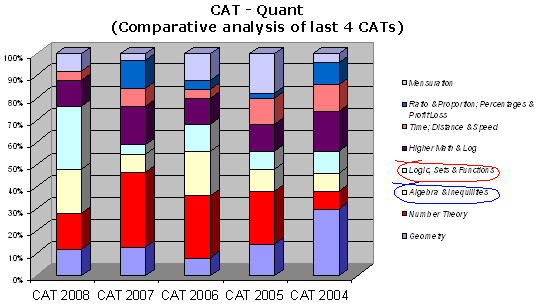
Image: A graphical analysis of the Quant section over the years.
If one looks at and analyses the CATs of the last five years, a factual and accurate list of topics to be covered can be prepared. Our analysis of CAT 2004, 2005, 2006, 2007 and 2008 can be summarised as follows:
Quantitative Analysis
It can be inferred from the trend that the cut-off for one IIM call every year requires 25 to 30 per cent correct questions in this section. That means those with reasonable accuracy in 'Number Theory' (never less than 15 per cent); 'Logic, Sets and Functions' (never less than 8 per cent) and Higher Math (never less than 10 per cent) can be assured of clearing the Quant cut-off in a given year.
Image: A graphical analysis of the Verbal section over the last few years.
It can be inferred from the trend that the cut-off for one IIM call every year requires 28 to 32 per cent correct Verbal questions. It means those who have done thorough practice on Reading Comprehension and sentence completion (and gap-fills) question types, which together make up min 60 per cent of the CAT every year, would be assured of clearing Verbal cut-off in a given year.
Image: A graphical analysis of the DI section over the last few years.
It can be inferred from the trend that the cut-off for one IIM call every year requires 30 to 35 per cent correct DI questions. That means those with mastery over 'Analytical Reasoning-based questions' (never less than 32 per cent); can be assured of clearing DI cut-off in a given year.
Image: The section-wise contribution to the overall test.
Experts at TCYOnline.com have also summarised the contribution of the various sub-sections of Quant and Verbal sections in the exam (with reference to CAT 2008).
From the pie charts, it is quite obvious that Reading comprehension in Verbal, Geometry and Arithmetic and Algebra in Quant, and reasoning-based questions in DI have clean sweep over the other sub-sections in CAT.
On the other hand Para-Jumbles in Verbal and Ratio and Proportion and Profit-Loss had a negligible contribution to your CAT score. You must plan in order to cover and practice these topics thoroughly in order to score high in CAT 2009.
Image: Accuracy is more important than quantity
Photographs: Rediff Archives
The CAT is not about solving 90 questions in 120 minutes. It is about solving 60 to 65 questions with 85 to 90 per cent accuracy. To be able to attempt all the questions is not the mark of your achievement in CAT.
Speed and accuracy are the distinguishing factors among the test-takers. Here's how you can work in these few weeks to achieve the optimum combination of both before November 2009:
- Strictly follow a preparation schedule in order to eliminate the possibility of stress and pressure near November 10 and 15 that otherwise arises because of pending testing or revision. For instance, the free online course at TCYonline.com (https://www.tcyonline.com/cat2009/cat_tcy.html) comes with a pre-planned 16-week preparation schedule.
- Keep track of your performance in terms of your total attempt together with percentage accuracy. Online tools like TCY Analytics (https://www.tcyonline.com/cat2009/tcy_graphs.html) not only help in keeping record of your performance but also help you visualise your performance trends and comparisons on three important parameters: percentage correct, time per question and accuracy.
- Rank yourself on the above two points among your classmates. This clarity of goal will help you focus on the right aspect of your preparation.
Don't forget, since CAT 2009 is online, so should your preparation!



